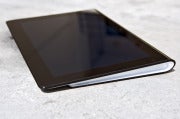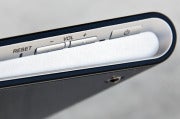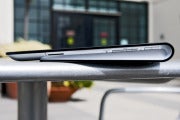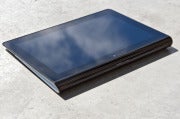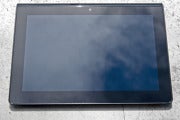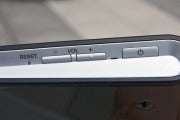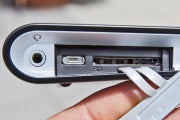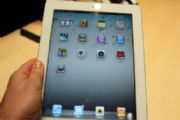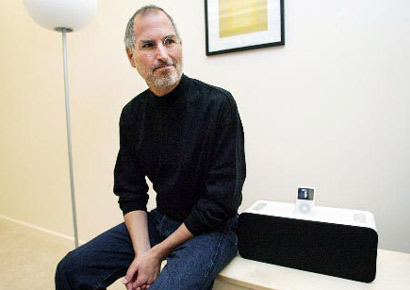Samsung Galaxy Tab 10.1 Wi-Fi: A Worthy Rival to the iPad 2
The Samsung Galaxy Tab 10.1 Wi-Fi is the first Android tablet to mount an effective challenge to Apple's iPad 2 in the area where Apple does best: design. And let's face it, where tablets are concerned, design occupies center stage. Happily for Samsung, the Tab 10.1--available in limited distribution starting today, starting at $499 for a 16GB version--parlays its design and its Android 3.1 operating system into a machine that vaults to the head of the Android pack.
In my hands-on testing, the Tab 10.1 achieved perhaps the best design compliment an Android tablet could hope for--often being mistaken by passers-by (including Apple iPad users) for an iPad 2. The confusion is understandable when you see and hold the Tab 10.1 for the first time. It has a slim profile of 8.6mm (0.34 inch)--a hair's breadth slimmer than the iPad 2's 8.4mm depth.
From the side, the two tablets look very similar. The Tab 10.1 edge is more rounded, though, while the iPad's is tapered. The tablet comes in two colors: Shipping first is the White model, which couples a silver-painted plastic edge with a white plastic back, and a Metallic Gray version, with edges and back that more closely match. I preferred the Gray version, which is less likely to be mistaken for Apple's ultrahip tablet, because I liked the feel and texture of the dark backing; the white backing somehow felt chintzier.
The Tab 10.1 weighs slightly less than the iPad 2, as well, at 1.25 pounds versus the iPad 2's 1.33 pounds. And it stands slightly taller and narrower than iPad: 10.1 by 6.9 inches, as against the iPad 2's 9.5 by 7.3 inches.
Using the Galaxy Tab 10.1 Wi-Fi
All of these details matter less, though, than how the Galaxy Tab 10.1 Wi-Fi handles. The Tab 10.1 feels lightweight and extremely well balanced; I found it comfortable to hold in one hand or two, and it weighed so little that I hardly noticed it was in my bag. I would still like to see the weight on tablets of this size drop closer to 1 pound, while the devices increase their built-in functionality with additional ports and other features; but this model is a significant step toward that goal--especially if you consider that (discounting the heavier, thicker, region-specific 10.1V) the Tab 10.1 is Samsung's first mass-market tablet of this size.
The Tab 10.1 takes minimalist design cues from Apple, as well. Beyond the docking port, it offers a power button and volume rocker at the top (in horizontal orientation) or along the right side (when held vertically). Also along the right top is the headphone jack; it's awkwardly situated if you hold the tablet horizontally and engage in video chat at the same time, because the jack is just above and to the right of where the camera is. But if you flip the orientation to put the jack at the bottom of the horizontal display, or if you hold the tablet vertically with the jack running along the right side, the jack's location works fine).
The stereo speakers are situated a little more than an inch down from the top, along the left and right horizontal edges. This positioning worked well, since my hands didn't get in the way of the speakers. The speakers were above average for an Android tablet sound system, and far better than the iPad 2's single rear-facing speaker. But audio still sounded too tinny on my test tracks.
The 1280-by-800-pixel-resolution display looked bright and brilliant, two characteristics we've come to associate with Samsung's phone and tablet displays. Like the 7-inch Galaxy Tab before it, the Tab 10.1 has a display that tends to oversaturate colors. On a color-chart test image, most of the colors, including reds and blues, were blown out. In our test images of sights and scenes, images popped but had a bit too much red and blue in the mix. In side-by-side comparison, the Apple iPad 2 generated better color reproduction, especially when in the soft browns of skin tones.
Still, the Tab 10.1 rendered images with terrific sharpness and detail. This is the first Android tablet to ship natively with Google's Android 3.1 update, and images clearly benefited from the updated OS, looking crisp and lacking any sign of the fuzzy rendering issue that plagued earlier Honeycomb versions.
Inside the Galaxy Tab 10.1
Like other Honeycomb tablets, the Tab 10.1 runs Nvidia's Tegra 2 platform, with a dual-core 1GHz processor and 802.11a/b/g/n Wi-Fi. The Tab 10.1 has many of the now-standard tablet accouterments like rear- and front- facing cameras (3- and 2-megapixels, respectively, with rear flash), a gyroscope, an accelerometer, a digital compass, and an ambient light sensor.
The Galaxy Tab 10.1 Wi-Fi's specs have changed--for better and for worse--since its introduction atCTIA in early 2011. Most notably, the weight has decreased from 1.31 pounds to 1.24 pounds. Unfortunately, that weight reduction might be due to the now-departed microSD card slot--a disappointing late scratch in an area that would have given the Tab 10.1 a significant advantage over the iPad 2. Also missing so far is any mention of a 64GB version, which Samsung had previously announced was in the works.
The Tab 10.1 supports Adobe Flash, but my test unit came without Flash preinstalled. Nor did the unit have a shortcut on the desktop linking directly to Adobe's Flash Player on the Android Market, as other Honeycomb tablets have done to handle the Flash installation conundrum (Flash is not native to the Android OS).
And yet other, positive file-support surprises abound. The Tab 10.1 supports Windows Media audio and video files (including .WMA, .WMV, and .AVI)--formats that Android 3.1 doesn't natively support--so Samsung deserves credit for jumping in to the fill the void here. The Tab 10.1 can also read Xvid, another format not cited on Android's official list.
The Tab 10.1 comes preloaded with Quickoffice HD, for reading and editing Microsoft Word, Excel, and PowerPoint files and for file browsing. (Interesting observation: Files that I downloaded via Gmail appeared only in the Download folder, even though the images and videos appeared directly in the Gallery app, and even though the music showed in the Music app.)
As shipped, the Tab 10.1 comes with the stock Android 3.1 OS on board, with very little customizing. The Tab 10.1 is the first Honeycomb tablet to ship with Google's facile Android Movie Studio (Google's answer to Apple's iMovie on iOS). In addition, it offers a customized keyboard from Nuance, with trace typing capabilities. This keyboard is the default keyboard, but you can switch to the native Honeycomb keyboard if you prefer. I liked the Samsung keyboard: It's gray with black letters, large keys, and mostly useful shortcut keys such as @, .com, and :-) in the e-mail keyboard.
Beyond that, you get Samsung's attractive orange-and-blue sunrise-like wallpaper scheme; Samsung Apps, Samsung's nascent and (for now) irrelevant app store; Samsung Music Hub, a music store and player powered by 7digital; and the Pulse news reader.
Samsung's more customized overlay, TouchWiz UX, will be available later this summer as an over-the-air update. It's not available preinstalled at launch, Samsung says, because the company didn't have time to test it thoroughly with Android 3.1. When the overlay does arrive, Samsung says, users can opt to use elements of it, or they can revert to stock Android. That said, we won't know the details of the implementation until it arrives.
TouchWiz UX will add various interface customizations to improve Android 3.1's usability. It will also add Samsung's Media Hub movie and TV purchase and rental service, along with Reader Hub (powered by Kobo Books and Zinio) and Social Hub (for accessing social networks under one roof).
Of special interest to business users: You can set the Tab 10.1 to encrypt user data; and it supports enhanced Exchange ActiveSync, Cisco AnyConnect SSL VPN, and F5 SSL VPN.
What You Sacrifice
To achieve its slim and light design, Samsung's Galaxy Tab 10.1 Wi-Fi accepts some compromises that may temper its appeal, depending on your needs. Like the iPad 2, it has no ports beyond its docking port, which is centered along the horizontal bottom edge. To add connectivity, you must invest in the optional dongles due to arrive later this month.
Samsung will have docking port dongles to add USB, SD Card, and HDMI, but all of these feel like the afterthoughts they are. It would be nice to get to a point where at least HDMI and USB connectivity are integrated directly into the tablet. Many competitors in the red-hot tablet space build in at least one such port--but those competitors are also far heavier, at 1.5 to 1.65 pounds. Once the dongles are available, I'll update this review with further hands-on testing.
Another thing I noticed in my casual testing: The 7000-mAh battery took inordinately long to charge. After 2 hours plugged in, my test unit had reached only about 30 percent charged. The battery is rated for up to 9 hours of use.
Stay tuned for our full PCWorld Labs performance test results, including battery life and recharge times.
The full-scale launch of the Samsung Galaxy Tab 10.1 Wi-Fi is scheduled for June 17, when you'll be able to buy the tablet at Best Buy, Fry's Electronics, and Micro Center; and online at Amazon.com, Best Buy, Newegg, and Tiger Direct. The 32GB version is priced at $599, $100 more than the 16GB model; both prices match Apple's comparable offerings. Additional mobile broadband versions will come; Verizon starts its presale today for 4G versions of the Tab 10.1, at a $130 premium over the Wi-Fi prices (that's the same premium as for the 4G iPad 2).

